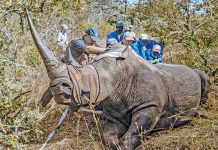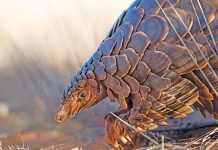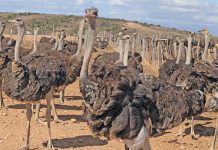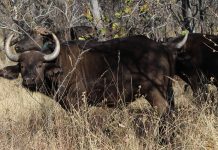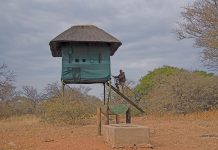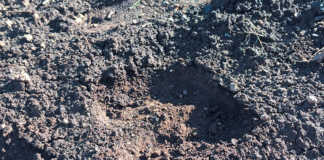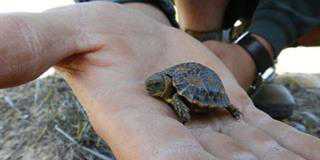The past four years have seen unprecedented growth in the industry, with some animals selling for several million rand at game sales. Buffalo farming pioneer Lindsay Hunt explores this phenomenon and examines its sustainability.
South African farmers face volatile times. The lack of government support, fluctuating land values, stock theft, unstable exchange rates, and threats of expropriation play havoc with modern farming. But farmers are resourceful, and farming ingeniously and indigenously may offer new opportunities. A classic example is Elandsberg Farms in Wellington, traditionally a wheat and sheep operation. In 1999, looking at diversification options on 30ha of irrigable land, it chose buffalo over wine, olives and other produce.
The result has combined remarkable returns on investment with very low running costs. Buffalo generate more profit per hectare than sheep, wheat and tourism combined. They’re a moveable asset, unlike cultivation in which all one’s money is invested into the ground.
Where’s this massive market?
Buffalo historically occurred all over Southern Africa where adequate shade, water and grazing was available – from the Cape Peninsula, along the southern coastal belt, into areas of the Karoo and up into the Highveld and Lowveld.The closing and restriction of hunting in much of Africa, combined with a steady drop in trophy quality due to poor management and excessive poaching, has focused attention on South Africa. Selective breeding and genetic variation is restoring what years of hunting has eliminated. The buffalo is arguably Africa’s most coveted trophy and essential ecotourism asset on any game reserve. Owners of game lodges are fuelling demand by seeking a return on their buffalo investment, through tourism revenue, and through breeding better-quality animals. Buffalo are immensely marketable animals for farmers with the necessary resources.
They’re easily restrained by cattle fencing and don’t require huge tracts of land. They provide a financial return within four years of acquisition. They’re selective bulk grazers. They’re hardy animals and mortality is very rare. They relocate and adjust with little stress. Under ideal conditions they can calve every 14 months. They are neither susceptible to stock theft, nor to poaching (when compared to white rhino). And, much like cattle, they’re easily trained to accept supplementary feed and to gather at a central feeding site.
Types of buffalo
All buffalo in South Africa are of one species, but are defined by ecotype – Kruger, Addo, KZN, Madikwe, and East African. These distinctions will diminish over time as breeders mix genetics to improve herds through hybrid vigour. Historically, buffalo in South Africa have been restricted to four ecotypically defined groups: Addo disease-free animals, Umfolozi-Hluluwe corridor and bovine tuberculosis (BTB) positive animals, Kruger National Park (KNP) infected animals and disease-free stock from foreign zoos.
Originally, only Addo buffalo and stock from foreign zoos were available as disease-free stock. Of the first three groups, KNP buffalo are the most genetically diverse, as proved by Prof Eric Harley from the University of Cape Town. However, buffalo from foreign zoos were excluded from his genetic variance study. If KNP buffalo were to be made available to buffalo farmers in the disease-free regions of South Africa, they had to be certified disease-free.
But how?
Breeding disease-free buffalo from disease-positive parent stock is a relatively recent breakthrough in Southern Africa. The pioneers worked with Dr John Condy, a veterinarian with the then-Rhodesian veterinary department. His far-sighted approach laid the foundations for future projects – but he was 20 years ahead of his time. It wasn’t until 1998 that Hunt Africa launched the first commercial project in South Africa to breed disease-free animals beyond the foot-and-mouth disease (FMD) red-line, using techniques developed by Dr Condy and Dr Roy Bengis of Skukuza. The success of this project has seen many other projects developing, all contributing to the spread of buffalo into areas where they have long been extinct. Two buffalo ecotypes – disease-free KNP buffalo and disease-free KwaZulu-Natal (KZN) buffalo – are available as a result of these projects.
Why the controversy?
The KZN and Addo buffalo originate from greatly reduced nucleus herds decimated by a combination of hunting, habitat destruction and the rinderpest of the 1890s. Arguments rage about the real number of buffalo left in these nucleus herds. Prof Harley’s research shows that the number was too small to prove loss of genetic diversity – which is conclusive in itself.KNP buffalo have wide genetic diversity. So why would current owners of KZN and Addo buffalo not all buy as many disease-free KNP bulls and cows as possible to improve their genetic lines? Prof Harley stated that substantial variability could be maintained in these populations by regular introduction of individuals from the KNP population. KNP buffalo have been available since 1999, yet many buffalo farmers have resisted the opportunity to improve their genetics, mainly due to the risk of disease.This is a stumbling block as few buyers understand the disease implications, and some breeders claim to be “less risky” than others. There’s also a belief that Addo and KZN buffalo are less risky than disease-free KNP stock are, and that East African buffalo are the least risky of all.
The East African market is an entirely separate and even less quantifiable model. Buffalo were exported to European zoos before 1960, and before Dr Robert Hedger and Dr Condy discovered that buffalo were carriers of FMD. The exact origin of these animals and their genetic diversity is difficult to measure. East African animals have, to date, always sold at a premium on the perception that they have the widest horns and are scarcer. Their “clean” status has also contributed to their price premium. Quite simply, prices are driven by supply, demand and perception.
Buffalo projects or disease-free herds?
Many questions surround the disease-free buffalo projects and the risk they introduce to the industry.
Disease is best controlled at source, and the easiest way to monitor it is by testing. Controlling disease at source is a subjective exercise performed by the breeder. As it’s impossible to enforce disease control at source, the agriculture department imposes strict quarantine, testing and movement restrictions on all buffalo bred in the disease-control area. These controls are very effective. This same level of control isn’t in place to monitor the movement of cattle, which arguably poses a higher risk of certain diseases than the strictly monitored buffalo projects do.As buffalo from established disease-free herds only require one blood test before being moved, it’s unfair to suggest that Addo or KZN animals are any less risky than disease-free KNP animals, which are more thoroughly tested by the time they qualify as stage-five animals.
When comparing the disease status of a fifth-stage project buffalo or a second-generation project buffalo with that of any other buffalo, the reality is that buffalo are only as clean as their last herd test.
So, in sourcing the cleanest buffalo, also examine the source, and the integrity of that source.
The future of buffalo marketing
The disease-free breeding projects are due to close at the end of 2011 as the agriculture department believes adequate genetic stock has been exported from the KNP gene pool over the last 12 years.
This will cause a massive contraction in supply. Fortunately, the market is changing and informed breeders are going to great lengths to source superior animals from the widest possible gene pool to ensure the future value of their investment. This approach will become increasingly popular as game farmers become averse to the genetic bottlenecks prevalent in line-bred herds. The sudden loss of KNP genetic material can only bolster demand. In the future, buffalo will be judged phenotypically – by what they look like. Big bodied, big horned animals with excellent fertility will ultimately sell for a premium, regardless of origin.
Some breeders over-emphasise horns and a particular horn shape. Some even argue in favour of line-breeding big horned animals and ignoring body size. The supply of phenotypically impressive disease-free animals with excellent genetic diversity is very limited. Small numbers of excellent-quality animals reach the market each year largely because, until recently, the focus has been on quantity above quality. Many buyers have focused on simply establishing a herd, regardless of the quality of the stock. Once a herd is established, improving its quality is time consuming and expensive – a very gradual process that hugely restricts supply and hugely increases demand. So it’s not surprising that exceptional bulls are selling for millions of rand and that the value of exceptional cows will continue to escalate.Few ungulates in Southern Africa have the wide habitat range and tolerance of the African buffalo. The growth of South Africa as a tourist and safari destination will ensure excellent returns in disease-free buffalo over the next 10 years.E-mail Lindsay Hunt at [email protected]. |fw
The disease dilemma
Buffalo are hosts to two African diseases, namely foot-and-mouth and corridor disease. Both can be determined by a blood test. Both have little or no effect on buffalo, but are dangerous to non-resistant ungulates, especially domestic livestock.Buffalo can also contract bovine tuberculosis (BTB) and brucellosis or contagious abortion (CA), European diseases alien to Africa. Buffalo act as carriers and hosts, and are affected by the diseases. These diseases are difficult to detect and can often be present, undetected, in a herd even if regular blood tests are done.
Buffalo from disease-free breeding projects are rigorously tested. They must pass a minimum of four negative tests in differing stages of quarantine, before being moved. These tests include a skin reaction test for BTB, and blood tests for the other three diseases. The protocol is designed to make sure no animal reaches a clean area (stage 4), unless certified clean of all four diseases. There’s some dispute over corridor disease transfer – an article in itself.Until “project” buffalo reach the fifth and final stage of testing, they remain a higher risk than animals born into disease-free herds. But many would agree that a fifth-stage Kruger National Park project buffalo is as clean as any other.

